Hospitals Were One of the Stronget Patrons F the Arts During the Reniassance
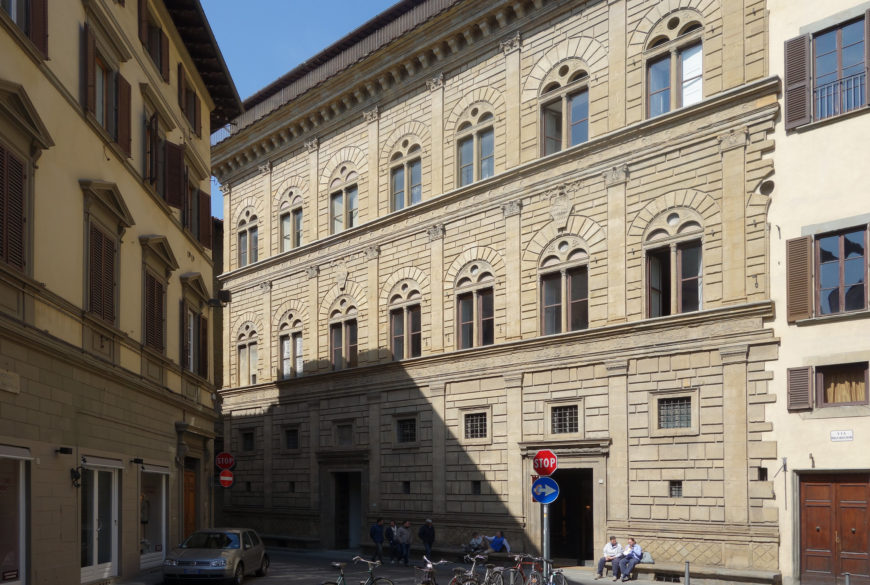
Leon Battista Alberti, Palazzo Rucellai, c. 1446–51, Florence, Italy (photo: Steven Zucker, CC BY-NC-SA two.0)
What'southward in information technology for me?
Why would someone patronize fine art in the renaissance? Giovanni Rucellai, a major patron of art and architecture in fifteenth-century Florence, paid Leon Battista Alberti to construct the Palazzo Rucellai and the façade of Santa Maria Novella , both high – profile and extremely costly undertakings. In his personal memoir, he talks about his motivations for these and other commissions, noting that "All the to a higher place-mentioned things accept given and give me the greatest satisfaction and pleasure, considering in part they serve the laurels of God likewise every bit the honour of the city and the commemoration of myself." [1]
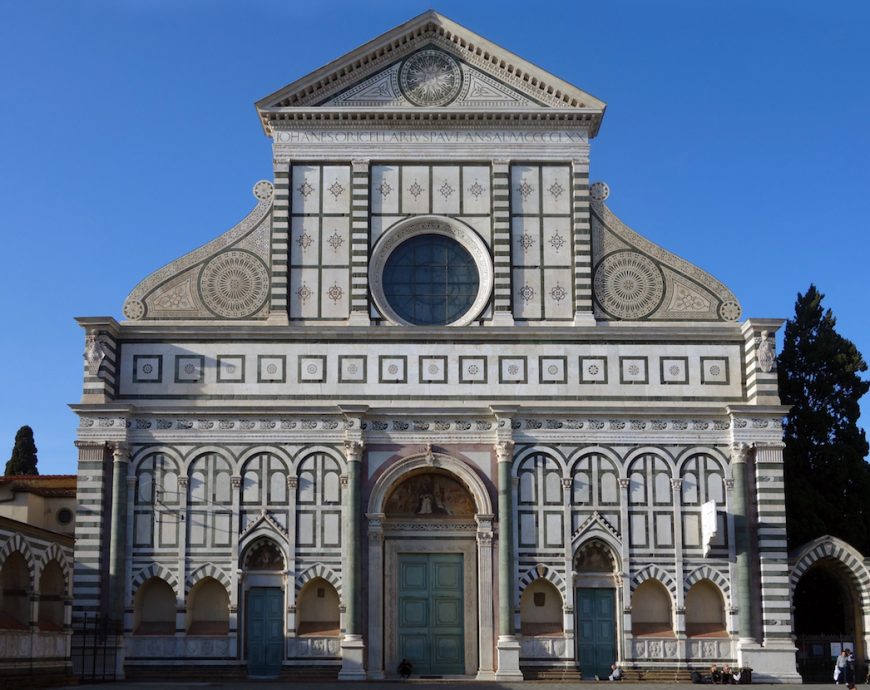
Leon Battista Alberti, Façade of Santa Maria Novella, Florence, 1470 (photograph: Steven Zucker, CC BY-NC-SA 2.0)
Bated from bringing honor to one's faith, city, and self, patronizing art was also fun. Earning and spending coin felt proficient, peculiarly the spending office. As Rucellai goes on, "I actually think that it is even more pleasurable to spend than to earn…." [2]
The aboriginal Roman world (with which much of renaissance Europe was endlessly fascinated) also provided motivation for patronage. The liberal expenditure on fine art and compages past ancient Roman patricians was celebrated in the literature of antiquity and survived—even if in fragmentary form—to dazzle the eyes of renaissance viewers. The Roman Emperor Augustus, who so famously said that he found Rome a metropolis of brick and transformed information technology into a metropolis of marble, provided the ultimate noble model of patronage.
Self-fashioning
Commissioning an artwork often meant giving detailed directions to the creative person, even what to include in the piece of work, and this helped patrons fashion their identities. While the identity of Bronzino's Florentine sitter in a Portrait of a Fellow is unknown, the artist shows him standing confidently in the composition's centre, looking out at u.s.a. while dressed in expensive black satin, slashed sleeves, and a codpiece consummate with golden aglets. He holds his fingers betwixt the pages of a poetry volume, which rests atop a table carved with grotesque faces. The volume and the table were undoubtedly intended to convey the man's sophistication and learning while his wearable and upright posture showed his wealth and dignity.
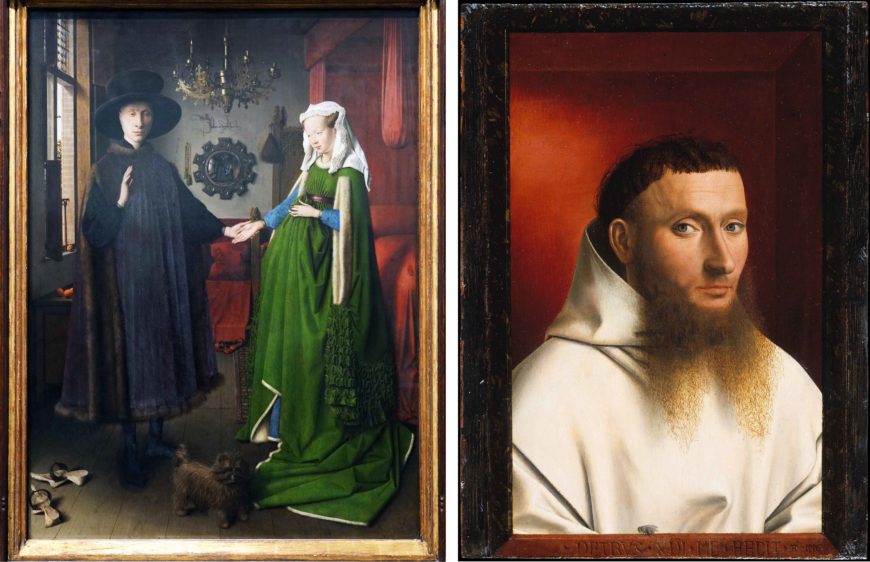
Left: Jan Van Eyck, The Arnolfini Portrait, 1434, tempera and oil on oak panel, 82.2 x lx cm (National Gallery, London; photo: Steven Zucker, CC Past-NC-SA two.0); right: Petrus Christus, Portrait of a Carthusian, 1446 (The Metropolitan Museum of Art)
The renaissance was also a time when increasingly wealthy centre-grade merchants and others aspired to increase their social recognition and began to commission portraits, as nosotros see in double portraits like Jan van Eyck's The Arnolfini Portrait showing the Italian merchant Giovanni de Nicolao di Arnolfini with his wife in Bruges (in nowadays-solar day Belgium). Petrus Christus's Portrait of a Carthusian reveals the increasing prominence of religious figures, with clergy, monks, and nuns sitting for portraits, many of which were likely fabricated to gloat the entry of wealthy individuals into religious orders.
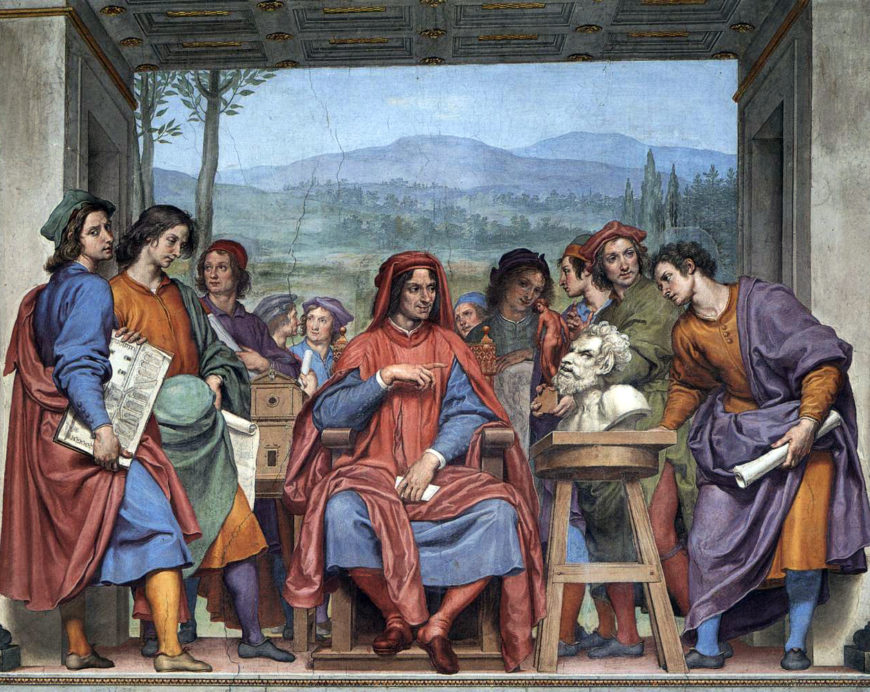
Ottavio Vannini, Michelangelo Presenting Lorenzo the Magnificent de' Medici with his Sculpture of a Faun, 17th century, fresco, Palazzo Pitti, Florence
Wealth, power, and condition
In a seventeenth-century fresco by the artist Ottavio Vannini, Michelangelo, the creative person, is shown presenting the powerful Florentine, Lorenzo the Magnificent de' Medici, with a sculpture of a faun. Lorenzo sits at the center of the paradigm, facing frontally like a ruler, while Michelangelo stands off to the side, bowing respectfully towards him. While today the name Michelangelo is ameliorate known, in the fresco the Medici patron is shown as more important than the artist.

Left: Leon Battista Alberti, Basilica of Sant'Andrea, 1472–90, Mantua (Italian republic) (photograph: Steven Zucker, CC: By-NC-SA three.0); right: El Escorial, begun 1563, most Madrid, Espana (photo: Turismo Madrid Consorcio Turístico, CC By 2.0)
Paying for something lavish and awe-inspiring, such equally Sant'Andrea in Mantua (deputed by Ludovico Gonzaga, ruler of the Italian city-state of Mantua and built by Alberti) or El Escorial (commissioned by Philip Two, King of Spain, outside of Madrid), was a powerful statement about a patron's wealth and status. Philip II was deeply involved in the planning of the massive complex that became El Escorial (a monastery, palace, and church). The circuitous was built in an austere, classicizing manner that was intended to showcase Philip'southward regal power by looking to ancient Roman architectural forms.
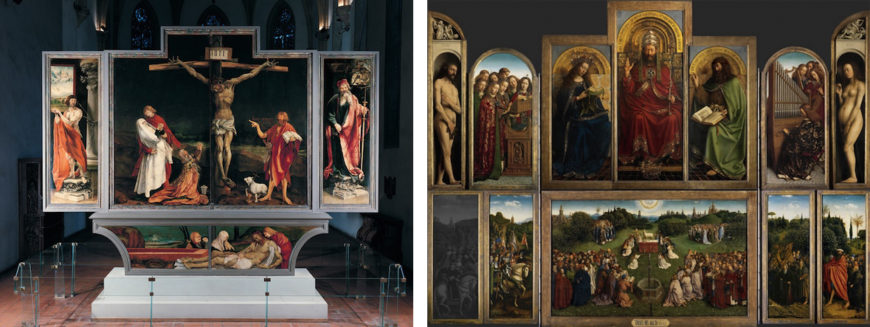
Left: Matthias Grünewald, Isenheim Altarpiece, view in the chapel of the Hospital of Saint Anthony, Isenheim, c. 1510-15, oil on wood, nine′ ix 1/2″ 10 ten′ 9″ (airtight) (Unterlinden Museum, Colmar, France); right: Jan van Eyck, Ghent Altarpiece (open), completed 1432, oil on wood, 11 feet 5 inches ten 15 feet ane inch (open up), Saint Bavo Cathedral, Ghent, Belgium. Note: Simply Judges panel on the lower left is a modern copy (photo: Closer to Van Eyck)
Spiritual comfort and salvation
Some patrons paid for art to serve a larger purpose, perhaps to fulfill a devotional or religious demand, equally the Isenheim Altarpiece did for people suffering from the painful disease of ergotism. Others commissioned art to expiate the patron'south sins for such things equally usury, as Jodocus Vijd desired when he paid a large sum of money for the Ghent Altarpiece .
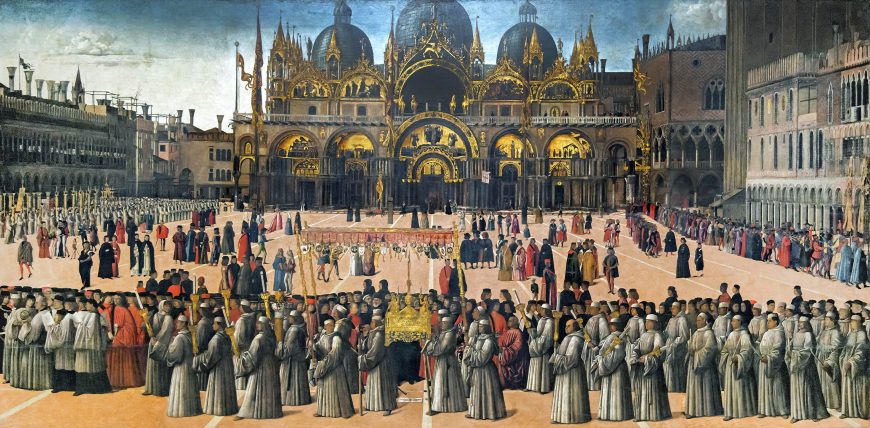
Gentile Bellini, Procession in St Marker's Square, 1496, tempera on canvas, 347 10 770 cm (photo: Steven Zucker, CC: Past-NC-SA 3.0; Gallerie dell'Accademia, Venice)
Inspiring civic duty and responsibleness
Commissioning artworks also helped to inspire civic responsibleness or to demonstrate that members of a particular customs performed their duties properly. The Scuola Grande di San Giovanni Evangelista , one of many Venetian devotional confraternities, paid Gentile Bellini to depict the procession of the relic of the Truthful Cross through St. Mark'due south square. This committee highlights the importance of the miraculous object equally well every bit the civic duty of the city's citizens, who are shown in the painting's foreground, with the Scuola members carrying a awning above the relic.
Patrons in art
Patrons often had themselves incorporated into paintings and sculptures to remind viewers of who had paid for the work of art as well as to show themselves participating in the narrative. We call these "donor portraits." Lluis Dalmau'southward Virgin of the Councillors , for instance, shows the Virgin Mary enthroned, belongings the baby Jesus and surrounded past saints in a luxurious Gothic interior. Kneeling before the saints, at the edge of the throne, are five men, all of whom were members of the Barcelona City Council (Casa de la Ciutat), who had paid Dalmau to create the painting to hang in the chapel at the council palace. The portrait collapses sacred and secular time, placing the men equally perpetually revering Mary and showcasing their piety to anyone observing the painting.
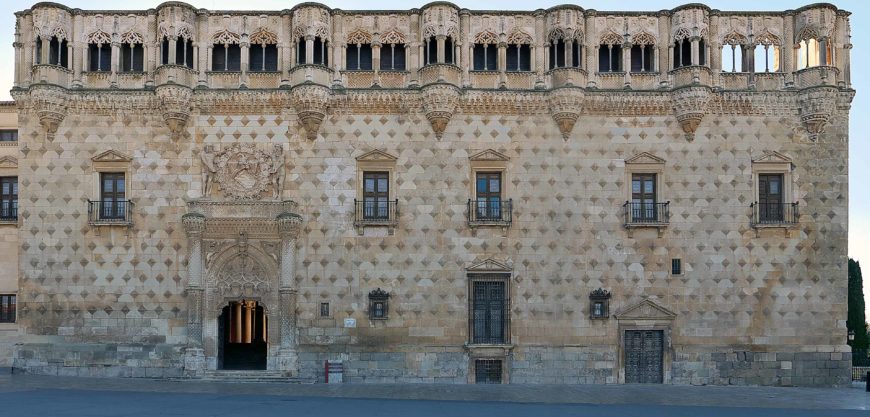
Juan Guas, Palacio del Infantado, 1480, Guadalajara, Spain (photograph: José Luis Filpo Cabana, CC Past iii.0). The patron was Íñigo López de Mendoza y Luna.
Even in instances where patrons were not overtly depicted in artworks, artists would sometimes exist directed to include heraldic symbols, visual puns, or other motifs to insinuate to the patron. The coat of arms of the wealthy Mendoza family rests in a higher place main entrance to the Palacio del Infantado (in Guadalajara, Spain) amidst the decorative plateresque elements, and advertizement to any passersby who had paid for and lived in the striking palace.
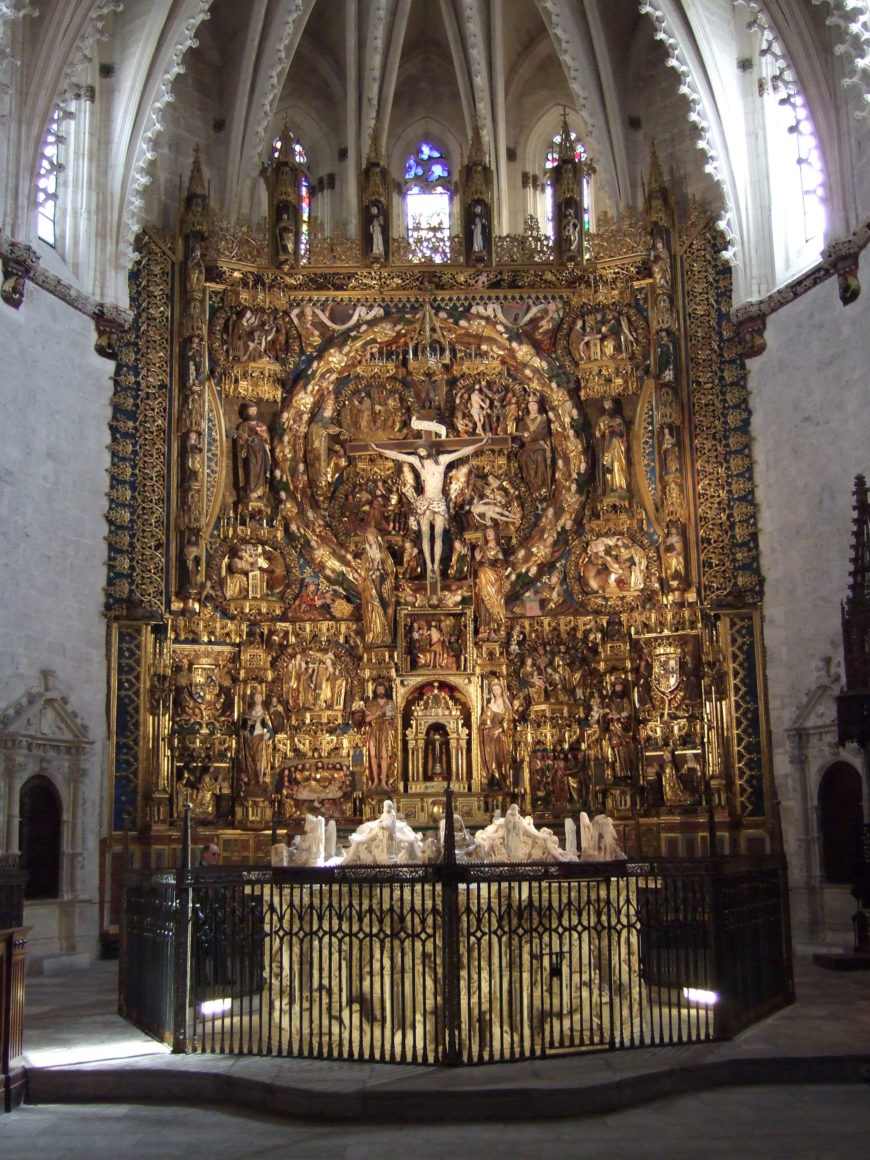
The Tomb of Juan II of Castile and Isabel of Portugal in front of the altar of the church of the Carthusian Monastery of Miraflores (photo: Ecelan, CC Past-SA four.0)
Patrons as influencers
Patrons also set fashions for style and subject field matter. Importing artists and artworks from distant lands could show off one's sophistication and introduce new styles, techniques, and subjects to local audiences. Artists and fine art traveled widely during this period, and exchanges across Europe and beyond were common. Because of the wealth and glamour of northern European court culture, information technology was fashionable for the wealthy elite of Italy and Spain to import both Netherlandish art and artists. Queen Isabel of Castile, whose father had favored Flemish painters such as Rogier van der Weyden, had a number of artists, including Juan de Flandes, Michel Sittow, and Gil de Siloe, at her court to create lavish works that would speak to her power and magnificence.
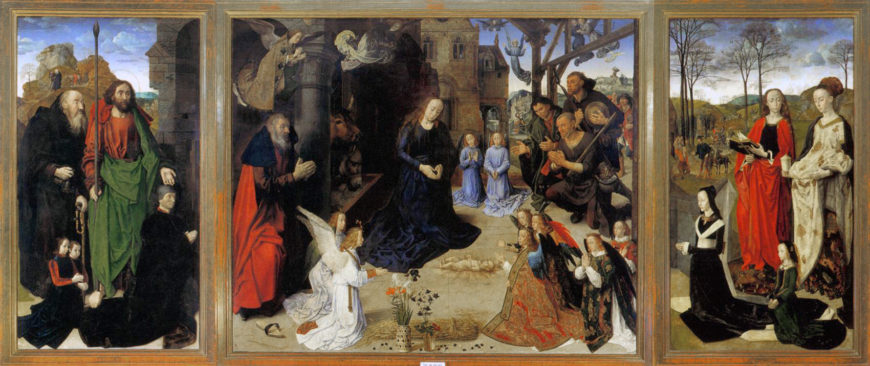
Hugo van der Goes, Portinari Altarpiece, 1476 and 1470, oil on panel, 253 cm 10 586 cm (Uffizi Gallery)
Likewise, Tomasso Portinari, who worked for the Medici depository financial institution in Bruges, hired the northern artist Hugo van der Goes to paint a massive altarpiece of the Nascency for his home town of Florence, Italy. When put on display in the hospital church of Santa Maria Nuova in 1483, it created a sensation. Italian artists, in awe of the accomplishments of the northern master, quickly responded to what they saw. Portinari not only showcased his own cosmopolitan sophistication, he besides helped shape the direction of Florentine art by introducing this spectacular image to local artists.
Why patrons matter
Art communicated ideas about patrons. Status, wealth, social, and religious identities all played out across paintings, prints, sculptures, and buildings. At the same time, the careers of artists were shaped with the aid of powerful patrons. Too, artistic styles emerged or developed as a result of patrons hiring artists or buying artworks and by transporting them to new locations. The history of art has been shaped not just by artists, but besides past the patrons whose choices in sponsorship adamant what art was created, who created it, who saw it, and what art was fabricated of. Until the modern era, the stories that accept been told in art are the stories that reflect the interests of the rich and powerful, the privileged few—generally men—who were in positions to patronize art. In a nutshell, patronage mattered.
Notes:
[1] Giovanni Rucellai, Giovanni Rucellai ed il suo Zibaldone , ed. Alessandro Perosa. 2 vols. (London: The Warburg Plant, University of London, 1960), 1:121
[2] Rucellai, Zibaldone , 1:121
Boosted resources
Read more virtually Isabella d'Este and her patronage
Larn more about patronage in fifteenth-century Burgundy
Explore renaissance Spain farther, and learn more than nearly the patronage of Queen Isabel of Castile
Learn more almost Patrons and Artists in Late 15th-Century Florence from the National Gallery of Fine art
Read about patronage at the subsequently Valois court on the Heilbrunn Timeline
Art from the Court of Burgundy: The Patronage of Philip the Bold and John the Fearless 1364–1419 ( Dijon, 2004)
Michael Baxandall, Painting and Experience in Fifteenth-Century Italia: A Primer in the Social History of Pictorial Mode , 2d ed. (Oxford: Oxford University Press, 1988)
Rafael Domínguez Casas, "The Artistic Patronage of Isabel the Catholic: Medieval or Modern?," in Queen Isabel I of Castile: Power, Patronage, Persona , edited by Barbara F. Weissberger (Boydell & Brewer, 2008), pp. 123–48
Alison Cole, Virtue and Magnificence: Art of the Italian Renaissance Courts (New York: H. N. Abrams, 1995)
Tracy E. Cooper, " Mecenatismo or Clientelismo ? The Character of Renaissance Patronage," in The Search for a Patron in the Heart Ages and the Renaissance , edited by David G. Wilkins and Rebecca L. Wilkins (Medieval and Renaissance Studies 12. Lewiston, NY: Edwin Mellen, 1996), pp. 19–32
Mary Hollingsworth, Patronage in Renaissance Italy: From 1400 to the Early Sixteenth Century (London: Thistle, 2014)
Robrecht Janssen, Jan van der Stock, and Daan van Heesch, Netherlandish Fine art and Luxury Goods in Renaissance Spain: Studies in Laurels of Professor Jan Karel Steppe (1918–2009) (Belgium: Harvey Miller Publishers, 2018)
Dale Kent , Cosimo De' Medici and the Florentine Renaissance: The Patron's Oeuvre (New Haven: Yale UP, 2000)
Catherine E. King and Margaret Fifty King, Renaissance Women Patrons: Wives and Widows in Italia, C. 1300–1550 (Manchester: Manchester Upward, 1998)
Sherry C. M. Lindquist, Agency, Visuality and Social club and the Charterhouse of Champmol (Aldershot and Burlington, 2008)
Michelle O'Malley, The Business concern of Art: Contracts and the Commissioning Process in Renaissance Italy (New Haven: Yale UP, 2005)
Sheryl Reiss, "A Taxonomy of Art Patronage in Renaissance Italy," in A Companion to Renaissance and Baroque Art , ed. Babette Bohn and James 1000. Saslow (Chichester, West Sussex Uk: John Wiley & Sons, 2013), pp. 23–43
Hugo Van der Velden, The Donor's Image: Gerard Loyet and the votive portraits of Charles the Bold (Turnhout, 2000)
Jessica Weiss, "Juan de Flandes and His Financial Success in Castile," Periodical of Historians of Netherlandish Art 11:one (Winter 2019) DOI: x.5092/jhna.2019.11.1.two
Cite this folio equally: Dr. Lauren Kilroy-Ewbank and Dr. Heather Graham, "Why commission artwork during the renaissance?," in Smarthistory, Apr 24, 2020, accessed Apr 29, 2022, https://smarthistory.org/renaissance-patrons/.
Source: https://smarthistory.org/renaissance-patrons/
0 Response to "Hospitals Were One of the Stronget Patrons F the Arts During the Reniassance"
Post a Comment